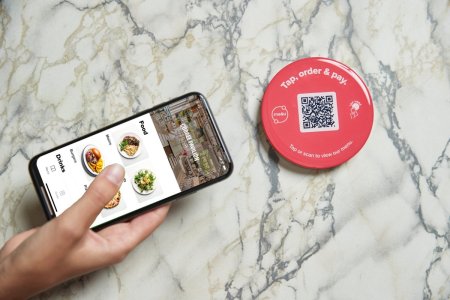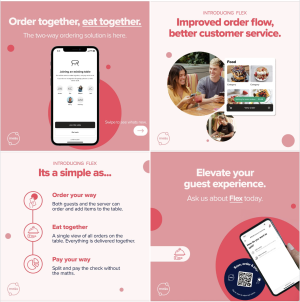Aussies split over QR code use: ‘Only making everything worse’
Many seniors are navigating the ever-evolving world of technology, trying to keep up with its constant changes.
However, some may struggle to keep pace, especially with frequent updates or innovations.
One of these advancements is using QR (Quick Response) codes for day-to-day transactions.
Aussies have united in protest against a controversial restaurant trend that gained popularity across the country during the COVID-19 pandemic.
Many have expressed frustration with the ongoing practice of ordering food and drinks through QR codes on their mobile phones rather than having the convenience of interacting with a staff member or placing orders at the counter.
One dissatisfied diner’s complaint gained significant attention this week after they visited an eatery on Queensland’s Sunshine Coast.

‘Went to a restaurant earlier in Sunny Coast, asked for a menu—the only menu they had was on the door and was directed to a QR code menu on the table,’ they said in a social media post.
‘It’s for this f***ing web app called me&u which proceeded to charge a 6.5 per cent venue surcharge, a 2 per cent payment processing fee, and then had the audacity to ask for a tip (10, 15, 25 per cent) as the cherry on top.
They added how sick they were of technology supposedly intended to solve an issue ‘making everything worse and more inconvenient for everybody’.
‘I’m so f***ing tired of “tech” being used to solve an “issue” but only making everything worse and more inconvenient for everybody,’ they said.
Many others agreed enthusiastically and shared their dislike for sharing details.
‘You’re waiting for your own table and paying an extra fee for the privilege. It’s f***ed,’ one person commented.
‘It’s also a big stinking f***k you to anyone old or not tech savvy. All just to hoover up your data,’ another shared.
However, a few mentioned they preferred using QR codes to order their food as it eliminated the need to physically move to place an order and reduced interactions with staff.
‘I actually like the QR ordering because I don’t like people, but the surcharges and tipping can f*** off,’ one responded.
‘I love the QR codes–don’t need to leave the table to order another beer,’ someone else expressed.
Consumer Advocate Adam Glezer of Consumer Champion argued that tipping should only be expected when hospitality staff have delivered a service.
‘A tip is something you pay for good service and it’s optional,’ Mr Glezer explained.
‘In Australia, the waiting staff are on a much higher wage than those in America, where they rely on their tips,’ he noted.
‘It sounds like Australian businesses are trying to Americanise themselves. There is no justification for paying a tip before a service is provided.’
QR codes became the new standard of ordering during the COVID-19 pandemic as establishments reduced contact between staff and patrons.
While praised by some as one of the pandemic’s positive developments, many view them as tools for exploiting consumers.
Senior Lecturer Dr Veronica Jiang at the School of Marketing at the University of New South Wales (UNSW) Business School cautioned that restaurants shouldn’t go for a ‘one QR code fits all’ approach when it comes to customer service.
‘Fast speed is linked with fast food restaurants,’ she stressed.
‘Fine dining or mid-tier restaurants want to position themselves far away from fast food, because that justifies their high prices and because restaurants try to differentiate with good service.’
Jonathan Holmes-Ross, owner of Adelaide’s The Lost Dice board game restaurant, credited QR code ordering for a 25 per cent cost reduction.
‘We no longer have to take orders, work out bills and manually take payments,’ he pointed out.
‘This gives our wait staff more time to look after our customers and the kitchen has excellent order information as the accuracy of the orders is great.’
‘We now have very few mistakes saving us time and waste. We can also mark items that have run out instantly on the app by using stock levels, again avoiding the disappointment of (the) customer.’
Despite other businesses reaping the supposed benefits of QR code technology, some are still weighing their options.
Zoran Milosavljevic of Cafe Alexandria, located in Sydney’s Central Business District (CBD), mentioned that his business is presently exploring the use of this technology.
‘If a customer sees a congested line-up they may consider using the quicker alternative of a digital menu rather than moving onto another cafe,’ he expressed.
‘With COVID still around some tend not to like waiting in queues for the fear of catching something.’
Of course, there are also the hardliners who opt for the traditional customer experience of face-to-face interactions.
Zinc in Potts Point, situated in Sydney’s eastern suburbs, stands firm in its decision not to adopt the new approach.
‘We try to be a neighbourhood cafe,’ said owner Nigel Nickless.
‘We recognise our regulars, remember what they want, remember their coffee order, if you don’t know their name you make sure you know their coffee order.’

Members, we’d love to hear your thoughts on QR codes. Who among you here finds them convenient, and who may have reservations? Please share your experiences and thoughts with us in the comments below!
However, some may struggle to keep pace, especially with frequent updates or innovations.
One of these advancements is using QR (Quick Response) codes for day-to-day transactions.
Aussies have united in protest against a controversial restaurant trend that gained popularity across the country during the COVID-19 pandemic.
Many have expressed frustration with the ongoing practice of ordering food and drinks through QR codes on their mobile phones rather than having the convenience of interacting with a staff member or placing orders at the counter.
One dissatisfied diner’s complaint gained significant attention this week after they visited an eatery on Queensland’s Sunshine Coast.

The me&u app lets customers scan a QR code on a coaster, allowing them to browse the menu, place orders, make payments, and enjoy table-side delivery. Image source: Facebook/@meandu
‘Went to a restaurant earlier in Sunny Coast, asked for a menu—the only menu they had was on the door and was directed to a QR code menu on the table,’ they said in a social media post.
‘It’s for this f***ing web app called me&u which proceeded to charge a 6.5 per cent venue surcharge, a 2 per cent payment processing fee, and then had the audacity to ask for a tip (10, 15, 25 per cent) as the cherry on top.
They added how sick they were of technology supposedly intended to solve an issue ‘making everything worse and more inconvenient for everybody’.
‘I’m so f***ing tired of “tech” being used to solve an “issue” but only making everything worse and more inconvenient for everybody,’ they said.
Many others agreed enthusiastically and shared their dislike for sharing details.
‘You’re waiting for your own table and paying an extra fee for the privilege. It’s f***ed,’ one person commented.
‘It’s also a big stinking f***k you to anyone old or not tech savvy. All just to hoover up your data,’ another shared.
However, a few mentioned they preferred using QR codes to order their food as it eliminated the need to physically move to place an order and reduced interactions with staff.
‘I actually like the QR ordering because I don’t like people, but the surcharges and tipping can f*** off,’ one responded.
‘I love the QR codes–don’t need to leave the table to order another beer,’ someone else expressed.
Consumer Advocate Adam Glezer of Consumer Champion argued that tipping should only be expected when hospitality staff have delivered a service.
‘A tip is something you pay for good service and it’s optional,’ Mr Glezer explained.
‘In Australia, the waiting staff are on a much higher wage than those in America, where they rely on their tips,’ he noted.
‘It sounds like Australian businesses are trying to Americanise themselves. There is no justification for paying a tip before a service is provided.’
QR codes became the new standard of ordering during the COVID-19 pandemic as establishments reduced contact between staff and patrons.
While praised by some as one of the pandemic’s positive developments, many view them as tools for exploiting consumers.
Senior Lecturer Dr Veronica Jiang at the School of Marketing at the University of New South Wales (UNSW) Business School cautioned that restaurants shouldn’t go for a ‘one QR code fits all’ approach when it comes to customer service.
‘Fast speed is linked with fast food restaurants,’ she stressed.
‘Fine dining or mid-tier restaurants want to position themselves far away from fast food, because that justifies their high prices and because restaurants try to differentiate with good service.’
Jonathan Holmes-Ross, owner of Adelaide’s The Lost Dice board game restaurant, credited QR code ordering for a 25 per cent cost reduction.
‘We no longer have to take orders, work out bills and manually take payments,’ he pointed out.
‘This gives our wait staff more time to look after our customers and the kitchen has excellent order information as the accuracy of the orders is great.’
‘We now have very few mistakes saving us time and waste. We can also mark items that have run out instantly on the app by using stock levels, again avoiding the disappointment of (the) customer.’
Despite other businesses reaping the supposed benefits of QR code technology, some are still weighing their options.
Zoran Milosavljevic of Cafe Alexandria, located in Sydney’s Central Business District (CBD), mentioned that his business is presently exploring the use of this technology.
‘If a customer sees a congested line-up they may consider using the quicker alternative of a digital menu rather than moving onto another cafe,’ he expressed.
‘With COVID still around some tend not to like waiting in queues for the fear of catching something.’
Of course, there are also the hardliners who opt for the traditional customer experience of face-to-face interactions.
Zinc in Potts Point, situated in Sydney’s eastern suburbs, stands firm in its decision not to adopt the new approach.
‘We try to be a neighbourhood cafe,’ said owner Nigel Nickless.
‘We recognise our regulars, remember what they want, remember their coffee order, if you don’t know their name you make sure you know their coffee order.’
Key Takeaways
- Australians are frustrated with the practice of ordering via QR codes instead of with waitstaff or at the counter.
- A post detailing dissatisfaction with the practice online, which included a critique of restaurant surcharging and tipping, received a wave of support from other diners.
- Some consumers, however, preferred QR codes as they simplify patrons’ ordering process and reduce interactions with staff.
- Industry experts suggested businesses adopt the technology according to their client base, with one warning that high-end establishments distancing themselves from fast food should prioritise personal service over quick ordering.








